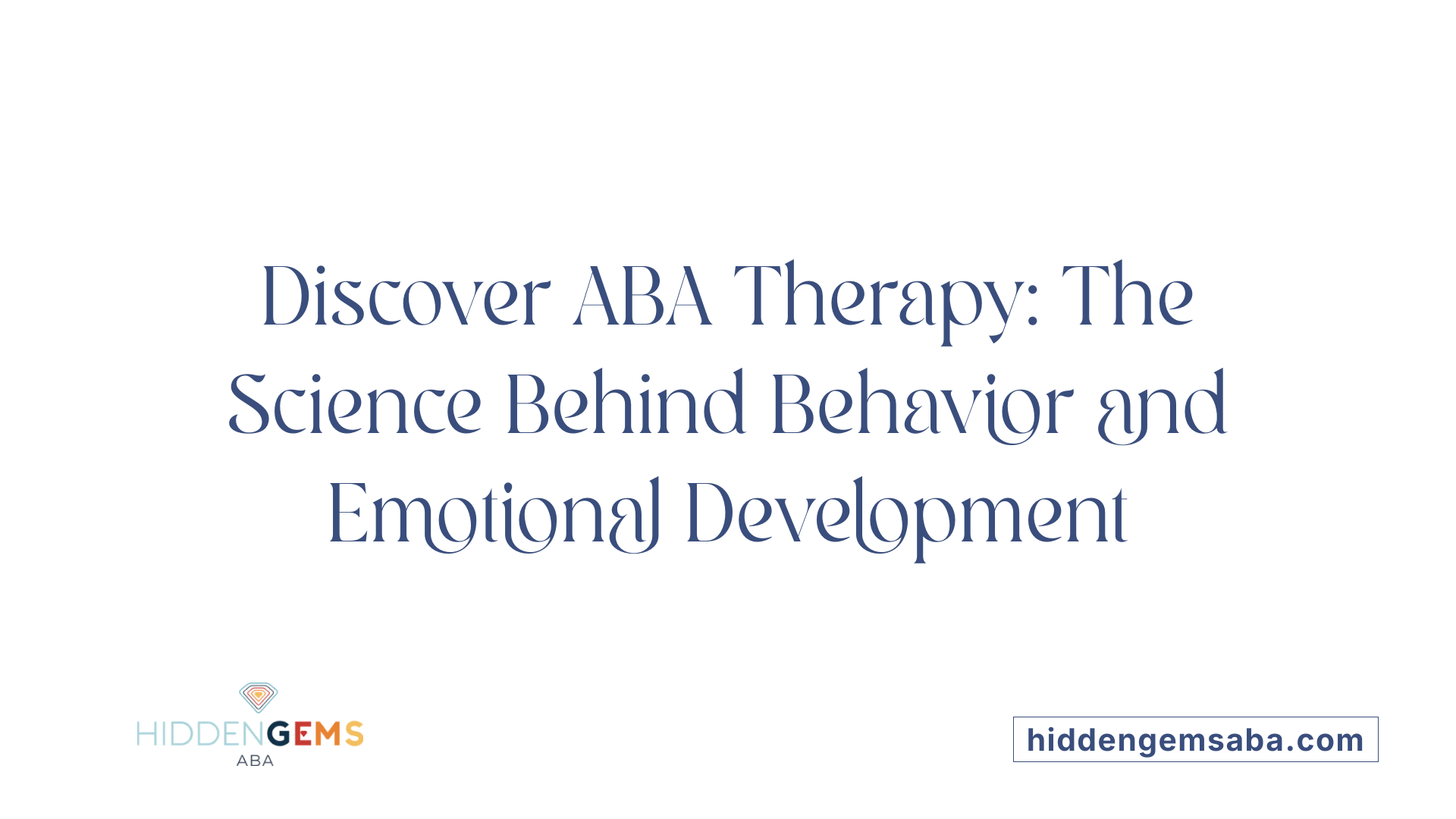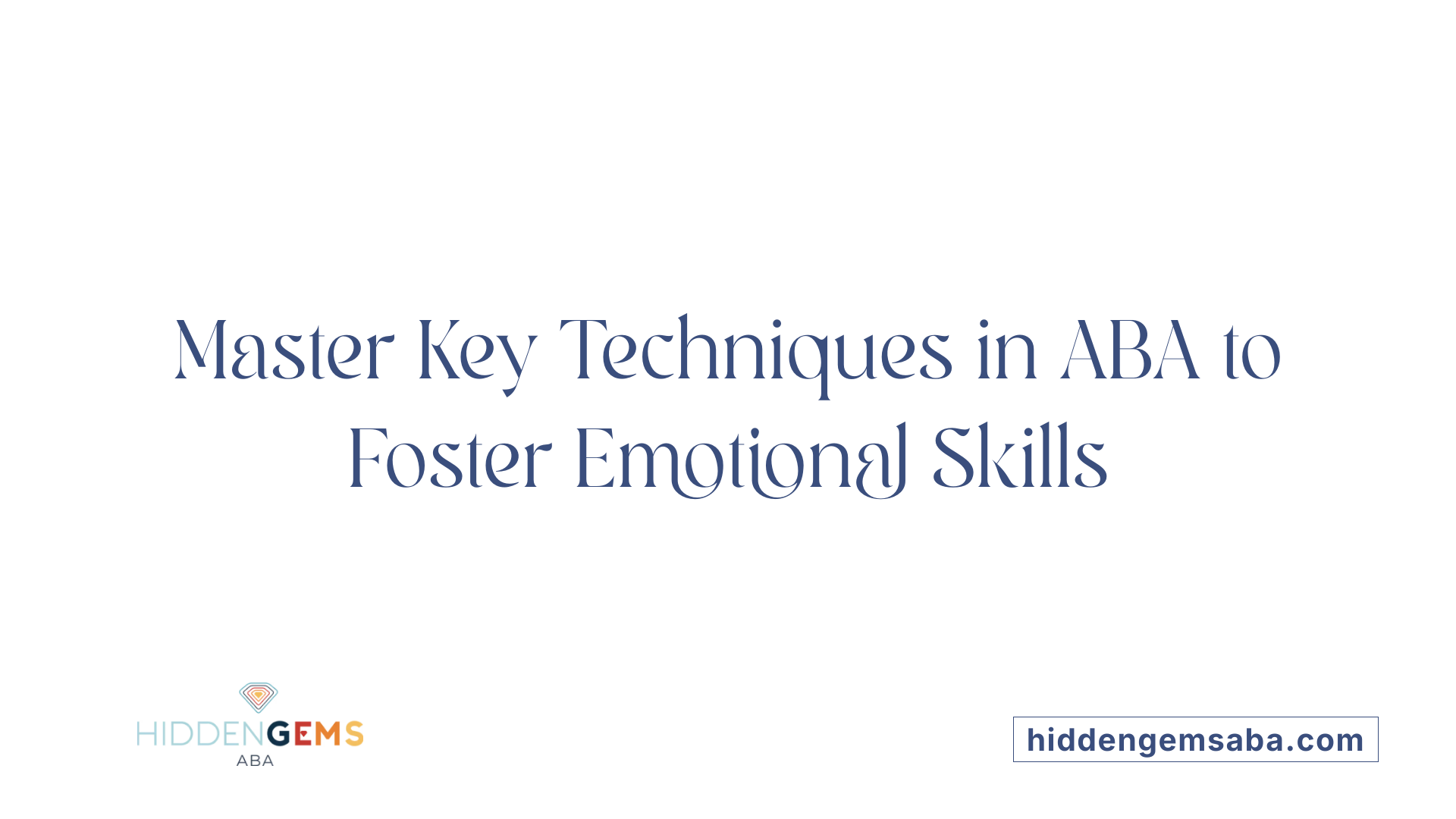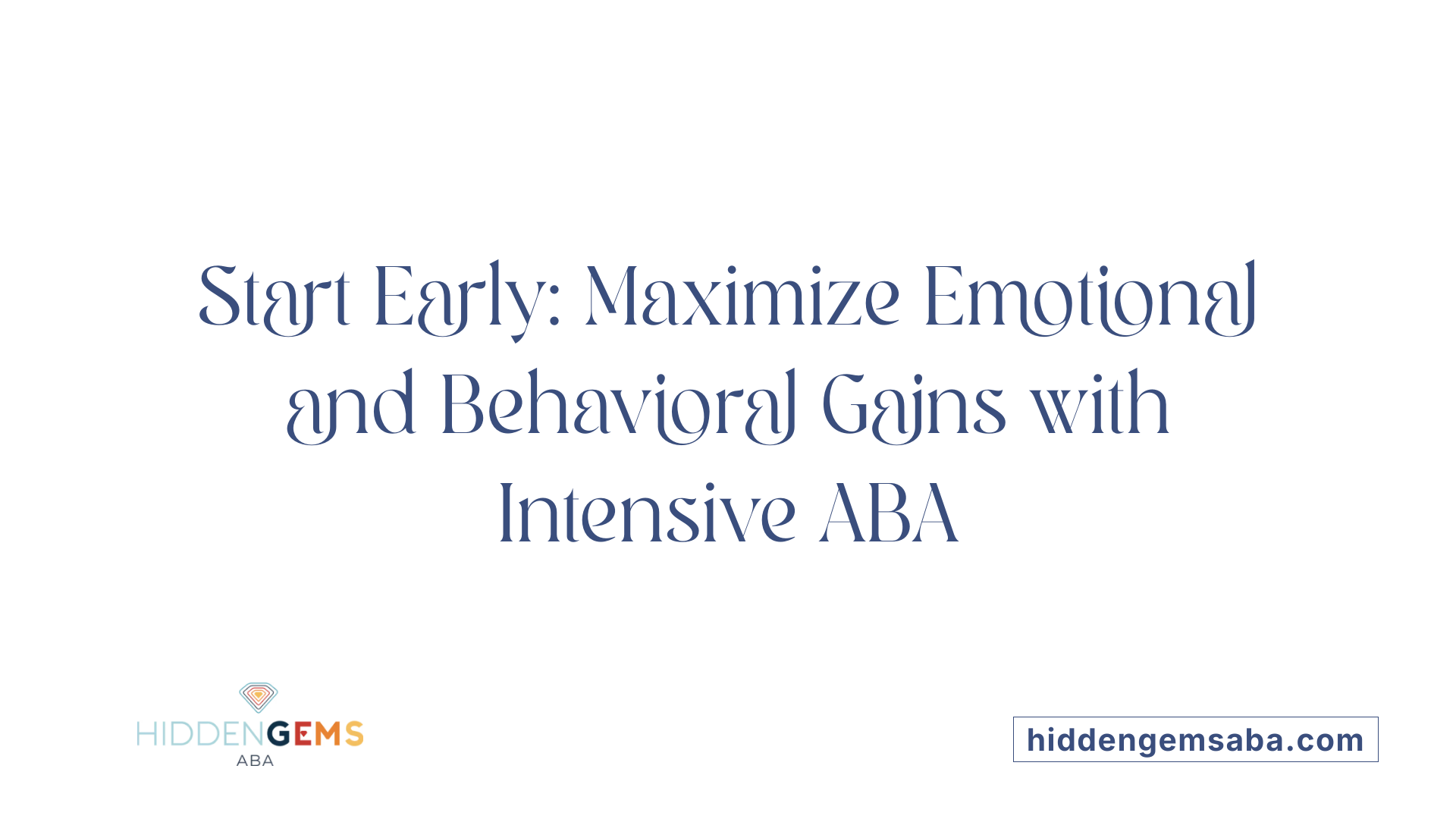Understanding the Role of Emotion in Autism Therapy
Helping children with autism understand and manage their emotions is a critical component of their development and overall wellbeing. Emotional recognition and regulation challenges are common among children on the autism spectrum, and tailored therapies can significantly improve these skills. Among these therapies, Applied Behavior Analysis (ABA) stands out as a science-based, evidence-supported approach that not only addresses behavioral challenges but also fosters emotional understanding through structured, individualized interventions. This article explores how ABA therapy and related strategies empower children with autism to better comprehend and express their emotions, ultimately enhancing their social skills, communication, and quality of life.
What Is Applied Behavior Analysis (ABA) Therapy?

Definition of ABA
Applied Behavior Analysis (ABA) therapy is a science-driven approach that focuses on understanding and modifying behavior by addressing environmental factors. The main goal of ABA is to encourage positive, helpful behaviors—like communication, social skills, and self-care—while decreasing harmful or interfering behaviors. ABA uses strategies such as positive reinforcement, where rewards (praise, toys, or activities) motivate and strengthen desired behaviors.
Evidence Base
ABA is widely recognized as an evidence-based intervention for autism spectrum disorder (ASD). Research, including meta-analyses and randomized controlled trials, shows ABA leads to improvements in language, cognitive skills, social functioning, and daily living abilities. Agencies such as the US Surgeon General, CDC, and American Psychological Association endorse ABA as a best practice treatment. Early and intensive ABA therapy—ideally begun before age six and lasting 25–40 hours per week—can yield significant long-term benefits.
Individualized Programming
Each ABA program is tailored by qualified professionals called Board Certified Behavior Analysts (BCBAs). They design therapy sessions based on detailed behavior assessments using the Antecedent-Behavior-Consequence (A-B-C) model. ABA therapy can be delivered one-on-one or in groups, across different settings such as home, school, or community environments. It breaks down developmental and behavioral goals into small, manageable steps, ensuring individualized treatment plans meet the unique needs of each child.
Goals of ABA Therapy Related to Emotions and Behavior
ABA aims to develop crucial skills including communication, social interaction, self-care, play, motor skills, and academics. It also helps children manage their emotions by teaching coping strategies and supporting behavioral regulation. The therapy focuses on fostering independence, improving understanding of social cues, and preparing children for everyday challenges. Progress is carefully monitored through ongoing data collection, allowing therapists to adjust interventions for optimal outcomes.
Overall, ABA therapy emphasizes respect for neurodiversity while using structured, evidence-based methods to enhance quality of life for individuals with autism.
How ABA Therapy Enhances Emotional Understanding in Children with Autism

Role of Emotional Regulation in Autism
Children with autism often face challenges in recognizing, expressing, and managing emotions. These difficulties can affect their social interactions and overall well-being. Emotional regulation is essential in helping children respond appropriately to various social and environmental stimuli, which supports better communication and relationship building.
ABA Strategies to Teach Emotions
Applied Behavior Analysis teaches emotional understanding by breaking down complex emotional skills into small, manageable steps. This systematic approach allows children to learn and master each component gradually. ABA therapists use techniques such as prompting and modeling to demonstrate appropriate emotional responses in different situations.
Positive Reinforcement in Emotional Learning
Positive reinforcement plays a crucial role in ABA therapy for emotional development. When a child successfully identifies or expresses an emotion, therapists immediately use rewards like praise, tokens, or preferred activities to reinforce the behavior. This encouragement increases the likelihood that the child will continue to apply these emotional skills in everyday interactions.
Breaking Down Emotional Skills into Small Steps
ABA programs carefully divide emotional skills—such as recognizing facial expressions, labeling feelings, and using coping strategies—into small, teachable units. This methodical teaching ensures that children with autism build a strong foundation in emotional understanding. As they progress, therapists support generalizing these skills to real-life situations, promoting improved emotional regulation and social success.
Core ABA Techniques for Teaching Emotional Skills

What techniques are commonly used in ABA therapy?
ABA therapy utilizes several effective techniques to teach emotional and other skills systematically. One foundational approach is positive reinforcement, where desired behaviors are encouraged by rewarding them with praise, toys, or preferred activities, strengthening the likelihood of these behaviors recurring.
Another widely used method is Discrete Trial Training (DTT), a structured teaching approach involving short, simple tasks delivered one at a time, with prompts guiding the learner and immediate reinforcement upon success. This method helps break down complex skills into manageable parts.
To aid learning, therapists employ prompting and fading strategies. Initially, they provide cues or assistance to help the child perform the behavior, then gradually reduce these prompts as the child gains independence, supporting skill mastery.
Visual and video modeling uses pictures or videos to demonstrate the desired emotional responses or behaviors. This modeling helps children understand and imitate appropriate emotional expressions and reactions effectively.
For teaching more intricate emotional behaviors, behavior chaining is applied. This technique breaks down complex actions into smaller, teachable steps that build upon one another sequentially, helping children learn multi-step emotional regulation or social interaction skills.
Together, these core ABA techniques provide a structured, supportive framework helping children on the autism spectrum develop essential emotional skills and manage behavior positively.
The Role of Qualified Professionals in ABA Therapy
Who provides ABA therapy services?
ABA therapy services are delivered by a team of trained professionals dedicated to ensuring individualized and effective treatment. The core members include Board Certified Behavior Analysts (BCBAs) and Registered Behavior Technicians (RBTs).
BCBAs as program designers
BCBAs play a critical role as the primary designers and overseers of ABA therapy programs. They conduct thorough assessments of the individual's behaviors and needs, then devise comprehensive, tailored treatment plans. These plans break down skills into manageable steps and incorporate strategies such as positive reinforcement and natural environment training to maximize learning. The BCBA continuously monitors progress through data collection and adjusts the program accordingly to ensure optimal outcomes.
RBTs implementation
Registered Behavior Technicians implement the treatment plans under the supervision of BCBAs. RBTs work one-on-one with children during therapy sessions in varied settings, including clinics, homes, schools, and community environments. Their responsibilities include providing direct instruction, reinforcing positive behaviors, and collecting data on the child's progress. Their close interaction helps maintain consistency and support in skill acquisition and behavior modification.
Parent and caregiver training
An essential component of ABA therapy involves training parents and caregivers to extend therapy beyond formal sessions. Qualified professionals, particularly BCBAs, provide education and coaching on ABA principles, enabling families to practice techniques during daily routines. This empowerment fosters generalization of skills, helps maintain progress, and integrates learning into real-life scenarios.
Collaborative, multidisciplinary delivery
ABA therapy is often part of a broader, multidisciplinary approach involving therapists, educators, and healthcare providers. Collaboration ensures that interventions are consistent, comprehensive, and address multiple areas such as communication, socialization, motor skills, and self-care. This teamwork enhances the supportive environment necessary for individuals with autism to thrive.
| Professional Role | Responsibilities | Setting Examples |
|---|---|---|
| Board Certified Behavior Analyst (BCBA) | Designs and supervises individualized ABA programs, assesses behavior, adjusts plans, trains caregivers | Clinics, schools, homes |
| Registered Behavior Technician (RBT) | Implements therapy sessions, provides direct instruction, collects data under BCBA supervision | Clinics, homes, schools, community |
| Parents/Caregivers | Learn and practice ABA techniques to support daily skill generalization | Home, community |
| Multidisciplinary Team | Coordinates interventions across communication, education, therapy, and healthcare | Various interdisciplinary settings |
Early and Intensive Intervention: Maximizing Emotional Growth

Why Is Starting ABA Therapy Early Beneficial?
Early intervention with Applied Behavior Analysis (ABA) significantly enhances emotional development in children with autism spectrum disorder (ASD). Beginning therapy ideally before age six leverages the brain's heightened plasticity, allowing faster acquisition and generalization of social, communicative, and emotional regulation skills.
What Are the Long-Term Outcomes of ABA?
Long-term ABA therapy, typically ranging from 25 to 40 hours per week over one to three years, has demonstrated meaningful improvements in multiple developmental areas. These include intellectual functioning, language, daily living skills, social interactions, and notably, emotional regulation. Early intensive and sustained ABA interventions help children learn coping strategies and reduce anxiety and problem behaviors, contributing to better quality of life and societal integration.
How Do Intensive Schedules Impact Progress?
Intensive ABA schedules provide frequent and repetitive learning opportunities, crucial for embedding skills and behaviors that support emotional growth. Consistent teaching sessions facilitate sustained positive reinforcement and practice in both structured and natural environments, enhancing social engagement and emotional understanding. Through such schedules, children also progress in self-care and adaptive skills which boost independence.
What Is the Role of Early Intensive Behavioral Intervention (EIBI)?
EIBI is a comprehensive ABA-based program delivered soon after diagnosis, usually involving one-on-one therapy over several years. It focuses on breaking down complex skills into manageable steps to foster cognitive, social, communication, and emotional development. Research shows EIBI participants achieve significant gains in IQ, receptive and expressive language, and adaptive behaviors, which include emotional regulation and reduced anxiety symptoms. Parent participation in EIBI further reinforces learning and emotional maturity outside therapy sessions.
These early and intensive ABA approaches underscore the importance of prompt, individualized interventions to maximize emotional and behavioral outcomes in children with ASD.
Naturalistic and Developmental ABA Approaches Supporting Emotional Skills
What are Pivotal Response Training (PRT) and how does it work?
Pivotal Response Training (PRT) is a play-based form of ABA therapy that focuses on encouraging pivotal behaviors, such as motivation and initiation of communication. Unlike more structured ABA methods that rely on repetitive discrete trials, PRT is implemented in natural settings like the home or clinic and uses the child’s interests to engage them. By targeting these pivotal behaviors, PRT aims to improve communication, play, and social skills in a more spontaneous and socially meaningful way.
How does the Early Start Denver Model (ESDM) support emotional and social development?
The Early Start Denver Model (ESDM) is an evidence-based early intervention approach tailored for children aged 12 to 48 months. It combines behavioral and developmental principles, emphasizing play and social exchange in natural environments such as home and clinics. Therapists and family members work together to help the child develop social, emotional, language, and cognitive skills. ESDM aims to reduce autism symptoms by fostering interactive learning and emotional regulation through fun, everyday activities.
How are play and everyday activities used in these naturalistic ABA approaches?
Both PRT and ESDM embed learning opportunities within play and daily routines. This naturalistic strategy allows children to practice new skills in contexts meaningful to them, increasing engagement and motivation. For example, during meals, dressing, or playtime, therapists or caregivers model and reinforce communication and social interactions, helping children generalize skills beyond the therapy setting.
How do these approaches encourage motivation and communication initiation?
Motivation is encouraged by following the child’s lead and reinforcing attempts to communicate, thereby making learning intrinsically rewarding. PRT specifically targets initiation of communication by recognizing and rewarding a child’s efforts to express needs or interact socially. This strategy not only increases positive behaviors but also boosts confidence and emotional connection, laying a foundation for improved social relationships and emotional wellbeing.
Parental Involvement and Training to Support Emotional Understanding

What Are Parent-Mediated Interventions (PMI)?
Parent-mediated interventions (PMI) involve training parents and caregivers to use ABA techniques at home to reinforce skills taught during therapy. These programs empower families to actively participate in their child's development, helping improve communication, social interaction, and emotional regulation.
How Does Home Reinforcement Enhance Therapy?
ABA therapy emphasizes giving children opportunities to practice skills in natural settings beyond structured sessions. When parents reinforce skills at home, children experience consistent encouragement which helps maintain progress and supports generalization to everyday situations.
How Are Caregivers Empowered with ABA Principles?
Qualified behavior analysts (BCBAs) provide caregivers with training on ABA strategies such as positive reinforcement, prompting, and data collection. This knowledge enables parents to respond effectively to their child's behaviors and fosters a positive learning environment.
Why Is Generalizing Skills Outside Therapy Important?
Generalizing skills ensures children can use what they learn in therapy during real-life interactions. Through parent involvement and home practice, children become better at recognizing and managing emotions across various settings, contributing to improved emotional understanding and social competency.
Complementary Therapies and Psychological Support for Emotional Wellbeing
How does Cognitive Behavioral Therapy (CBT) support emotional wellbeing in individuals with autism?
CBT is a psychological approach highly effective for addressing anxiety, depression, and other emotional challenges in adolescents and adults with autism spectrum disorder (ASD). By helping individuals change their thought patterns and reactions, CBT offers strategies to cope with negative emotions, manage stress, and improve overall mental health. Access to CBT can be limited due to a shortage of trained professionals, but it remains the leading recommended treatment for emotional difficulties.
What role do mindfulness and relaxation techniques play?
Mindfulness and relaxation therapies are complementary approaches used by some families alongside standard treatments. These methods focus on helping individuals with autism reduce stress and promote calmness through breathing exercises, meditation, and other relaxation practices. Although scientific evidence is less robust compared to behavioral interventions, these techniques can enhance emotional regulation when combined with established therapies.
How does sensory integration therapy contribute to emotional support?
Sensory integration therapy addresses difficulties with processing sensory information, which can often cause distress or behavioral issues in people with autism. This therapy involves structured activities that help individuals better understand and respond to sensory stimuli in their environment. Improved sensory processing can reduce anxiety and improve focus, thus supporting emotional wellbeing.
In what ways do social skills training and social stories support emotional health?
Social Skills Training (SST) uses behavioral principles to teach important social competencies that bolster confidence and reduce social anxiety. Techniques like social stories provide clear, visual narratives that help individuals anticipate and handle social situations, making social interactions less overwhelming. These methods contribute to better emotional regulation by improving communication skills and fostering positive social experiences.
These complementary and psychological supports, when integrated with primary behavioral interventions like ABA, offer a holistic approach to emotional wellbeing in individuals with autism spectrum disorder.
Measuring Progress: Data Collection and Outcome Tracking in ABA

Role of data in individualized ABA programs
Data collection is fundamental to Applied Behavior Analysis (ABA), enabling behavior analysts to tailor and refine interventions based on each individual's unique progress. During therapy sessions, precise data on behaviors—both desired and undesired—are recorded continuously. This systematic tracking helps practitioners identify which strategies are effective and which require modifications, ensuring treatment remains aligned with the child's evolving needs.
Adjusting therapies based on progress
ABA therapy is dynamic; therapists regularly analyze collected data to adjust goals, teaching methods, and reinforcement strategies. If progress stalls, techniques such as increasing positive reinforcement or modifying antecedents and consequences (from the 'A-B-Cs' model) are implemented. This responsive approach enhances skill acquisition and problem behavior reduction by optimizing the therapy’s relevance and challenge level.
Use of validated tools like Vineland Adaptive Behavior Scales
Clinicians often employ standardized assessment instruments such as the Vineland Adaptive Behavior Scales and Bayley Scales to measure adaptive functioning and developmental milestones comprehensively. These validated tools provide objective data on communication, socialization, daily living skills, and motor abilities, offering a broader view of the child's development and therapy outcomes beyond session-level observations.
Importance of long-term outcome measurement
While short-term behavioral improvements are frequently documented, measuring long-term outcomes—including quality of life (QoL) and sustained independence—is crucial for evaluating ABA’s enduring impact. Ongoing follow-ups and extended data collection support understanding of how early and intensive ABA intervention influences intellectual functioning, language skills, social integration, and daily living competencies over time.
| Aspect | Purpose | Example Tools/Methods |
|---|---|---|
| Session Data Collection | Track immediate responses and behaviors | Direct observation, frequency counts |
| Therapy Adjustment | Modify interventions based on progress | Data analysis, A-B-C model framework |
| Standardized Assessments | Evaluate developmental milestones | Vineland Adaptive Behavior Scales, Bayley Scales |
| Long-Term Outcomes | Assess sustained skill use and QoL | Follow-up assessments, caregiver reports |
Through meticulous data-driven practices, ABA therapy maintains its adaptability and effectiveness, offering measurable progress that informs continuous improvement for individuals with autism spectrum disorder.
Preparing Children with Autism for Real-World Emotional Challenges
Teaching social cues and emotional regulation
ABA therapy plays a critical role in helping children with autism recognize and interpret social cues, such as facial expressions, body language, and tone of voice. Through structured activities and natural environment training, therapists guide children in understanding emotions in themselves and others. This awareness is foundational for emotional regulation, empowering children to respond appropriately in social situations.
Coping strategies through ABA
ABA uses positive reinforcement to teach healthy coping mechanisms that children can apply when faced with emotional stress. Techniques such as play therapy and modeling help children practice calming strategies and behavior management skills. By breaking down coping skills into manageable steps, children gain the ability to manage feelings like frustration or anxiety effectively.
Support for independence and societal integration
ABA therapy prepares children for real-world challenges by fostering independence in daily living and social interactions. Group learning and natural environment training support the development of friendships and collaborative skills. These interventions encourage children to participate actively in school and community settings, promoting a sense of belonging and functional autonomy.
Reducing anxiety and improving social participation
Structured ABA programs also target reducing problem behaviors related to anxiety, such as separation anxiety, by gradually exposing children to social situations and teaching relaxation strategies. Enhancing communication and social skills through individualized instruction helps increase confidence, leading to better social participation and emotional well-being.
| Aspect | Strategy Used | Outcome |
|---|---|---|
| Social cues recognition | Natural environment training | Improved understanding of social signals |
| Emotional regulation | Positive reinforcement, play therapy | Increased capacity to manage emotions |
| Independence | Group learning, daily skills teaching | Greater autonomy and social integration |
| Anxiety reduction | Gradual exposure, relaxation techniques | Decreased anxiety and improved social engagement |
The Transformative Power of ABA in Emotional Development
Supporting children with autism in understanding and managing their emotions is a multifaceted journey that benefits immensely from evidence-based therapies like Applied Behavior Analysis. ABA's structured, data-driven, and individualized approach empowers children to develop critical emotional and social skills, laying a foundation for independence and richer social connections. With trained professionals guiding therapy and active involvement of families, ABA fosters meaningful progress that extends beyond clinical settings to real-world environments. Complementary therapies and long-term monitoring further enrich this developmental path. Ultimately, early and intensive ABA intervention offers children with autism vital tools to navigate life's emotional landscape, enhancing their quality of life and potential for fulfilling social engagement.
References
- Applied Behavior Analysis (ABA)
- Treatment and Intervention for Autism Spectrum Disorder
- Applied Behavior Analysis in Children and Youth with Autism ...
- Behavioral Therapy for Autism Spectrum Disorder in Children
- Behavioral Interventions for Autism Spectrum Disorder
- 6 Benefits of ABA Therapy for Children with Autism
- The effectiveness of applied behavior analysis program ...


.jpg)


